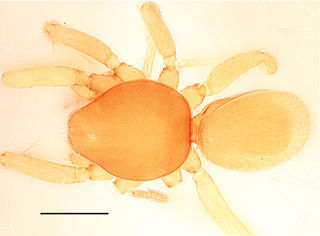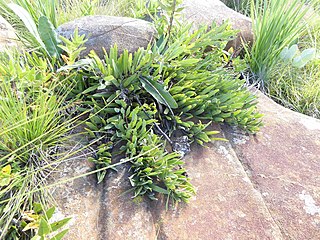
The common dwarf mongoose is a mongoose species native to Angola, northern Namibia, KwaZulu-Natal in South Africa, Zambia and East Africa. It is part of the genus Helogale and as such related to Helogale hirtula.

Urodidae or "false burnet moths" is a family of moths in the lepidopteran order. It is the type genus in the superfamily, Urodoidea, with three genera, one of which, Wockia, occurs in Europe.

The little yellow bat is a species of vesper bat found only in Mexico.

Grevillea parvula , commonly known as Genoa grevillea, is a species of the plant genus Grevillea. It is native to the states of Victoria and New South Wales in Australia.

Holothuria parvula, the golden sea cucumber, is a species of echinoderm in the class Holothuroidea. It was first described by Emil Selenka in 1867 and has since been placed in the subgenus Platyperona, making its full scientific name Holothuria (Platyperona) parvula. It is found in shallow areas of the Caribbean Sea and Gulf of Mexico and is unusual among sea cucumbers in that it can reproduce by breaking in half.

Falsomesosella is a genus of longhorn beetles of the subfamily Lamiinae, containing the following species:

Bannana is a genus of goblin spiders native to Xishuangbanna prefecture, Yunnan Province, China, where it lives in the leaf-litter of tropical rainforest. There are two known species: Bannana crassispina and B. parvula, both described in 2015. Individuals are pale yellow and unpatterned, and range from around 1.0 to 1.8 mm in body length, with females being slightly larger than males. The eyes are reduced or entirely absent. Known only from a nature reserve in Xishuangbanna, Bannana belongs to a group of Asian goblin spiders known as the "Dysderoides complex", that ranges from China to Pakistan and south to Indonesia.

Pachycondyla parvula is an extinct species of ant in the formicid subfamily Ponerinae described by from a fossil found in Europe. P. parvula is one of six Lutetian Pachycondyla species.
Nepenthes parvula is a tropical pitcher plant native to the Cape York Peninsula of Queensland, Australia.
Falsomesosella affinis is a species of beetle in the family Cerambycidae. It was described by Stephan von Breuning in 1938.
Falsomesosella bifasciata is a species of beetle in the family Cerambycidae. It was described by Stephan von Breuning in 1938.
Falsomesosella densepunctata is a species of beetle in the family Cerambycidae. It was described by Stephan von Breuning in 1968, originally under the genus Gyarancita. It is known from Laos.
Falsomesosella mediofasciata is a species of beetle in the family Cerambycidae. It was described by Stephan von Breuning in 1968.
Falsomesosella unicolor is a species of beetle in the family Cerambycidae. It was described by Stephan von Breuning in 1969.
Falsomesosella albofasciata is a species of beetle in the family Cerambycidae. It was described by Maurice Pic in 1925.
Falsomesosella nigronotata is a species of beetle in the family Cerambycidae. It was described by Maurice Pic in 1930.
Falsomesosella robusta is a species of beetle in the family Cerambycidae. It was described by Maurice Pic in 1944.
Falsomesosella grisella is a species of beetle in the family Cerambycidae. It was described by White in 1858. It is known from Taiwan.
Falsomesosella horishana is a species of beetle in the family Cerambycidae. It was described by Gressitt in 1938.

Protea parvula, also known as the dainty sugarbush, or kleinsuikerbos in Afrikaans, is a small flowering shrub belonging to the genus Protea.








